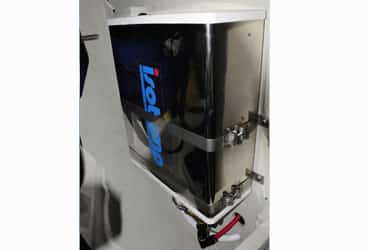
While it may look a lot like the one in your home, the marine water heater is a horse of a different color because many are designed to heat water in multiple ways, with varying results.
Nearly all water heaters will operate using either shore power or a generator. That is, AC current from either of these sources powers a heating element that’s immersed in the water, heating it to a temperature established by a thermostat. It’s important to note that electric water heaters are normally set to temperatures above 131 F to prevent the development of harmful bacteria, such as Legionella, the cause of Legionnaires’ disease, in the water supply. While many folks consider anything above about 105 F to be too hot, remember that hot water, when used, is often mixed with cold, so a higher setting will also mean that your hot water effectively lasts longer.
But most onboard water heaters can also operate by using heat from the engine while the boat is under way. The heat exchanger, much like the one that cools your engine or generator, simply transfers heat that’s generated elsewhere—in this case, in the engine’s closed cooling system—to the water inside the tank of the water heater. Instead of sending all of the excess heat created by the engine out with the exhaust, some of it is reclaimed for washing dishes, taking showers, and similar activities. What’s frequently not well understood by users is the fact that when the water is heated by the running engine, the electric thermostat exerts no control over the temperature of the water. This means that the water within the heater can be heated to the temperature of the engine’s coolant, creating a potentially dangerous scenario.
There’s only one way to control the temperature of water heated in this manner: by installing a tempering valve at the heater or anti-scald valves farther downstream, at the faucets. Tempering valves are easily added to virtually any water heater. The problem, though, is that many of them don’t react quickly enough to a surge of hot water to prevent scalding.
When a water heater is connected to an engine’s closed cooling system, certain protocols, as well as the engine manufacturer’s instructions, must be followed. Primary among these is the one governing the location, with regard to elevation, of the water heater. If the heat exchanger within the water heater or any portion of the plumbing between the engine and the water heater is located above the engine’s expansion-tank cap, then a remote expansion tank must be plumbed into the system. This tank, with its own pressure cap, then becomes the primary fill point for the closed cooling system, rendering the original legacy fill cap dormant and unusable. In most cases, when a remote expansion tank is installed, it must use the pressure cap called for by the engine manufacturer; the original cap located on the engine must then be replaced with a higher-rated cap; check with your engine manufacturer for specific instructions. This will ensure that the cap with the highest elevation in the system, the one that can vent air, is the only one that opens and closes with temperature-induced pressure changes.
Failing to install a remote expansion tank in the above-mentioned scenario could lead to air trapped within the cooling system, which in turn may lead to cold showers or, worse, an overheating engine.
Steve D’Antonio offers services for boat owners and buyers though Steve D’Antonio Marine Consulting.








